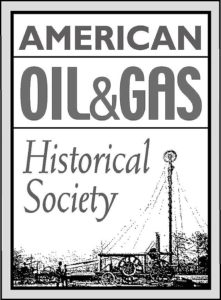by Bruce Wells | Sep 24, 2024 | Energy Education Resources
Western Pennsylvania collection of engines preserves a remarkable history of powering America.
Vintage oilfield engine exhibits are part of an unusual Pennsylvania museum in the rustic hills of Pennsylvania near Little Sandy Creek, just off Colonel Drake Highway 36, about 10 miles northwest of Punxsutawney.
Indoor and outdoor displays of rare engines, many carefully restored and maintained by volunteers, educate visitors about the 19th-century evolution of internal combustion technologies that helped end the age of steam.
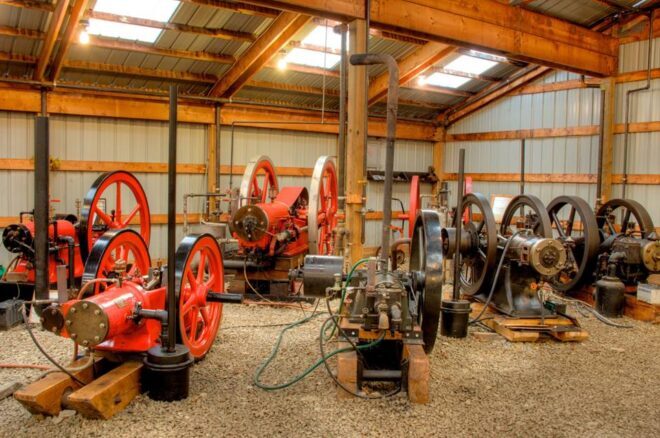
The Coolspring Power Museum opened in 1985 near Punxsutawney, Pennsylvania. It has the largest collection of historically significant stationary gas engines in the country, if not the world. Photo courtesy Coolspring Power Museum.
The Cool Spring Power Museum, which opened in 1985, exists thanks to its long-time director who spent decades collecting and preserving hundreds of engines of all shapes and sizes. In a 2004 interview, Dr. Paul E. Harvey explained why the collection was important.

“Internal combustion engines revolutionized the world around the turn of the 20th century in much the same way that steam engines did a century before,” noted Dr. Harvey, who co-founded the museum in 1985 about midway between Punxsutawney and Brookville, Pennsylvania.
“One has only to imagine a coal-fired, steam-powered, airplane to realize how important internal combustion was to the industrialized world,” added Dr. Harvey, a medical doctor.
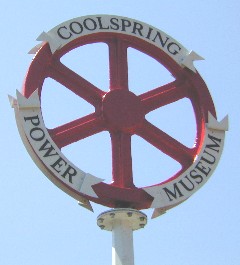
The museum hosts many summer events, including a “History Day and Car, Truck & Tractor Show.” Photo by Bruce Wells.
According to Dr. Harvey, permanent exhibits at Coolspring include stationary gas “hit and miss” engines, throttle-governed engines, flame ignition engines, hot tube ignition engines, and hot air engines ranging in size from a fractional horsepower up to 600 horsepower.
Many engine enthusiasts from around the country have sent significant pieces for display, he said. The grounds, as well as semi-annual shows, have expanded with visitors from Maine to California, as well as Canada and England.
Dr. Harvey explained that early internal combustion engines produced only a few horsepower and could not replace steam engines in most applications, but by 1890 they were powerful enough for most portable or remote operations as well as many small manufacturers.

By 1900 the new power technology was replacing reciprocating steam engines for electric generation, Dr. Harvey noted. “By 1915 they were being considered for all but the largest installations where steam turbines have since dominated,” he added. Dr. Harvey and fellow enthusiast John Wilcox began collecting engines in the 1950s. Their collections were the basis of displays that would greatly multiply.
The museum is housed in 20 buildings that, besides its own large collection, contain many pieces placed there on loan. Dr. Harvey said the purpose of Coolspring was “to be the foremost collection of early internal combustion technology presented in an educational and visitor-oriented manner and to provide an operation that will gain support and generate substantial growth.”
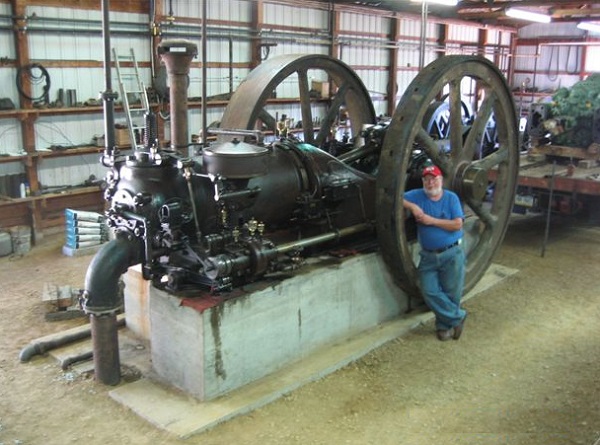
Dr. Paul Harvey, co-founder of the Coolspring Power Museum in Pennsylvania, next to a 175 HP Otto engine he restored with help of museum volunteers. Photo courtesy the Coolspring Power Museum.
The collection documents the early history of the internal combustion revolution. Almost all of the critical components of today’s engines have their origins in the period represented by the collection (as well as hundreds of innovations no longer used). Some of the engines represent real engineering progress; others are more the product of inventive minds avoiding previous patents. All tell a story.
Although the museum’s focus is on stationary engines (with perhaps the largest collection anywhere), Dr. Harvey explained that no museum of internal combustion engines would be complete without at least a few vehicles in its collection. Among the antique heavy trucks and semis, is a rare petroleum well service rig.
The Hanley & Bird Well Bailing Machine was designed to clean a well by lifting water, sand, and debris from the bottom of the well using a “bailer” attached to a cable, noted the museum director.
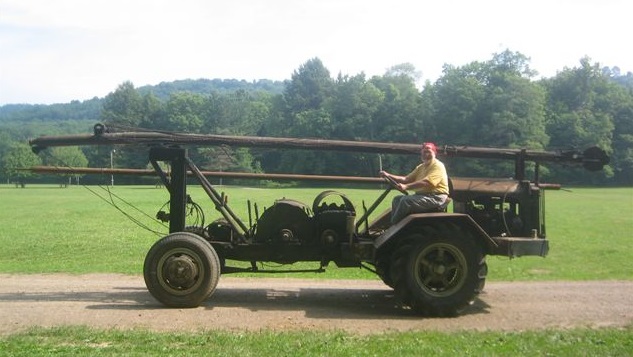
A “last of its kind” Hanley & Bird Well Bailing Machine from the Pennsylvania oilfields. Photo courtesy Coolspring Power Museum.
Five of the devices were built; the Coolspring Power Museum’s example is the only one to survive. “It was donated to the museum by EXCO Resources, the successor to H&B,” Dr. Harvey said. “It is very interesting as it uses a chain drive Mack rear end and a Ford front axle.”
Dr. Harvey recalled seeing the Hanley & Bird Well Bailing Machine driving through Coolspring on its way to service local natural gas wells. He said that the museum today displays it with the mast raised and ready to work. “It certainly shows the ingenuity of the local gas industry,” he reported.
The Coolspring Power Museum collection includes many engines used to power multiple wells in America’s first oilfields. The museum is off Route 36 midway between Punxsutawney and Brookville in western Pennsylvania.

As the steam engines revolutionized the world in the 1800s, the internal combustion engines on exhibit at the Coolspring Power Museum did the same at the start of the 20th century, according to Dr. Harvey.
“You have only to imagine a coal-fired, steam-powered, airplane to realize how important internal combustion was to the industrialized world,” the doctor added with a chuckle.
The Coolspring Power Museum hosts events in the spring and summer, including the History Day and Car, Truck & Tractor Show. The 2024 Spring Exposition included the museum bringing back its popular late 19th-century Foos Gas Engine Company gasoline engine (with timed fuel injection rather than a carburetor) and noting, “Foos was a very successful engine builder of a variety of types and sizes of efficient engines.”
_______________________
Recommended Reading: Around Titusville, Pa., Images of America (2004); Myth, Legend, Reality: Edwin Laurentine Drake and the Early Oil Industry
(2004); Myth, Legend, Reality: Edwin Laurentine Drake and the Early Oil Industry (2009); Oil on the Brain: Petroleum’s Long, Strange Trip to Your Tank
(2009); Oil on the Brain: Petroleum’s Long, Strange Trip to Your Tank (2008); A History of the New York International Auto Show: 1900-2000
(2008); A History of the New York International Auto Show: 1900-2000 (2000). Your Amazon purchase benefits the American Oil & Gas Historical Society. As an Amazon Associate, AOGHS earns a commission from qualifying purchases.
(2000). Your Amazon purchase benefits the American Oil & Gas Historical Society. As an Amazon Associate, AOGHS earns a commission from qualifying purchases.
_______________________
The American Oil & Gas Historical Society (AOGHS) preserves U.S. petroleum history. Please become an AOGHS annual supporter and help maintain this website and expand historical research. For more information, contact bawells@aoghs.org. Copyright © 2024 Bruce A. Wells. All rights reserved.
Citation Information: Article Title: “Cool Coolspring Power Museum.” Authors: B.A. Wells and K.L. Wells. Website Name: American Oil & Gas Historical Society. URL: https://aoghs.org/energy-education-resources/cool-coolspring-power-museum. Last Updated: September 30, 2024. Original Published Date: September 1, 2005.
.
by Bruce Wells | Aug 1, 2024 | Energy Education Resources
Central Texas oil museum preserves the discovery — and folklore — of a giant 1920s oilfield.
In a restored 1885 mercantile building downtown, the Luling Oil Museum (also known as the Central Texas Oil Patch Museum) exhibits historic drilling and production equipment from the Luling oilfield of the 1920s. While educating students about the modern petroleum industry, the museum gives little credence to the once widely told tale of Luling’s giant field being discovered thanks to a “reading” by a famous psychic.
Known for its tasty BBQ ribs, watermelon seed-spitting contest, and colorfully decorated oil pump jacks, Luling became part of U.S. petroleum history when leading citizen Edgar B. Davis discovered oil there in 1922.
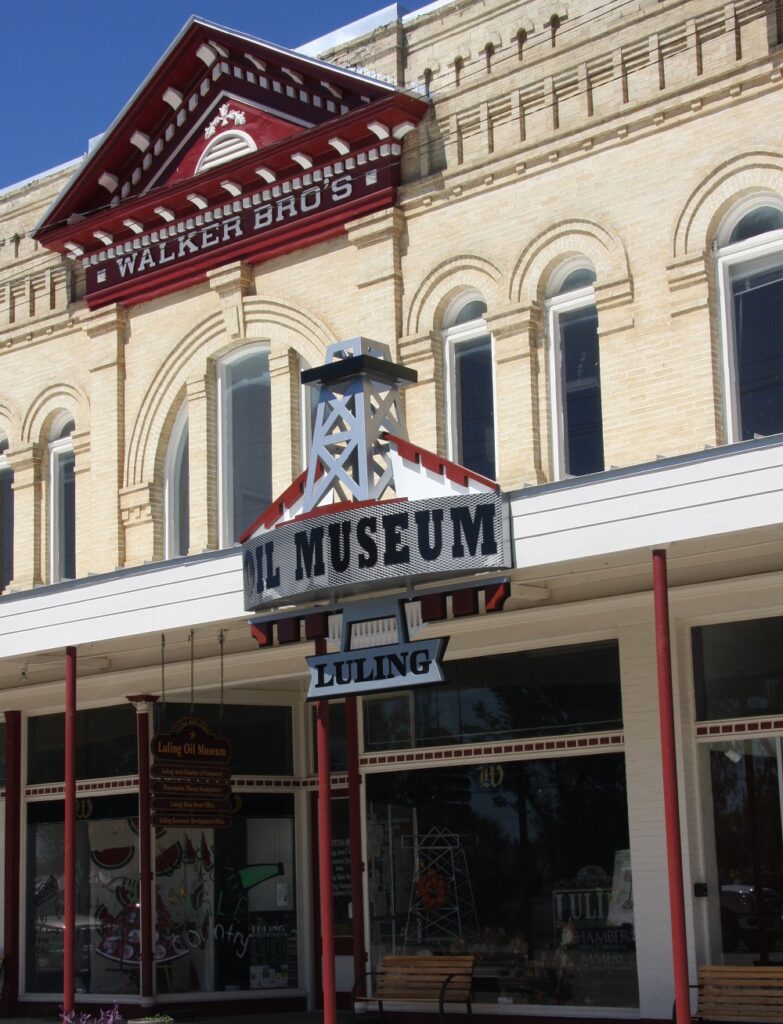
Exhibits in Luling’s restored 1885 mercantile store educate visitors about 1920s oil discoveries and their role in the Texas petroleum industry. Photo courtesy Luling Oil Museum.
Luling’s oilfield discovery northeast of San Antonio and south of Austin allowed the small town to join recent oil booms already making headlines to the north in Ranger (1917) and Burkburnett (1918). At its peak in 1924, the Luling field had about 400 wells producing more than 11 million barrels of oil.

Years later, new technologies like horizontal drilling helped reinvigorate the central Texas oil patch, according to Carol Voight, a director of the Luling Oil Museum interviewed by an Austin TV news reporter in 2013.

The city of Luling, Texas, has hosted a watermelon festival every June since 1954.
The oil museum, “shows the contrast of the tools and technology of the past with those utilized in the oil industry today,” Voight explained. Exhibits trace the development of the oil industry — from the first U.S. oil well in 1859 in Pennsylvania to the social and economic impact on central Texas.
Housed in the 1885 Walker Brothers mercantile store and renovated several times, the Luling Oil Museum building once sold “everything from nails and hammers to ladies shoes, to toys,” reported the Lockhart Post-Register in a 2021 article about the renovation. “It was the oldest continually operating mercantile store in Texas until it closed in 1984.”
After its founding in 1990, the Luling Oil Museum purchased the building four years later to showcase what made Luling one of the toughest boom towns in Texas. The historic building’s most recent renovation, which incorporated new heating, ventilation, and air conditioning powered by geothermal wells, has provided new exhibit spaces.
“We strive to demonstrate the struggles between the men and women who were the oilfield pioneers and to create a better understanding of the process of oil exploration and production,” noted one volunteer.
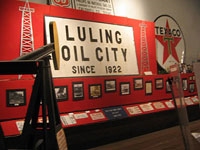
Edgar B. Davis in 1922 discovered an oilfield 12 miles long. Photo by Bruce Wells.
“Our collection includes a working model of a modern oil rig, pump jacks, the ‘Oil Tank Theater,’ and an excellent assortment of tools from each decade of the oil industry,” added Voight. To preserve the city’s petroleum heritage, locally donated artifacts show “not only how it was in the olden days,” but also “what can be accomplished with community efforts, cooperation, and creative programs.”
Museum staff in 2015 credited Luling area petroleum companies and service companies like Tracy Perryman, himself a multi-generation independent producer. One of the museum’s great outreach success stories was “Reflections of Texas Art Exhibit.”

Combined with the permanent oil exhibits, the art show attracted more school field trips from San Antonio. Another program was an annual quilt show, which brought another kind of audience into the museum’s oil exhibit spaces. Like many small oil and gas museums, preservation work depends on community support.
In a frugal approach to integrating downtown with outdoor exhibit space, the museum in 2012 partnered with Susan Rodiek, PhD, and graduate students of architectural design at Texas A&M University. Her student teams proposed designs to economically exploit existing facilities while providing new exhibit spaces. Students approached the project competitively, proclaiming the museum their “first client.”
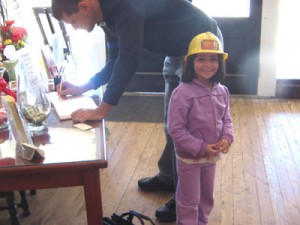
Dad signs the museum guestbook for this visitor. Photo by Bruce Wells.
Museum Association Board Member Trey Bailey noted, “The preliminary designs that the Aggie students presented to us were fantastic. There were some terrific concepts and the work was detailed and quite fascinating.”
Voight added, “They really got it – Luling’s rich heritage in oil, the E.B. Davis story and more. Being able to get this quality of work and vision is tremendous to our efforts to showcase some of the true historic gems of Luling. “Dr. Rodiek and her able team have again offered us the ability to get this project moving, especially considering the limited budget we have at this time.”
Once known as the toughest town in Texas, visitors today flock to Luling on the first Saturday in April for the annual Roughneck BBQ and Chili Cook-Off. — where they have found “Best ribs in the country,” according to Reader’s Digest. Crowds also gather every June for the renowned Watermelon Thump Festival and Seed-Spitting Contest.
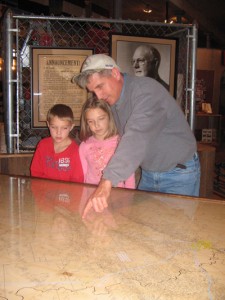
Museum Association Board Member Trey Bailey and his children examine a map of the 1920s Luling oilfield. Photo by Bruce Wells.
The Guinness Book of World Records has documented Luling’s watermelon seed-spitting with a distance of 68 feet, 9 and 1/8 inches, set in 1989. The distance reportedly is still unbeaten.
Learn petroleum history at the Luling Oil Museum.
Discovering the Luling Oilfield
Although the Luling Oil Museum’s historic Walker Brothers building was a center for trading cotton, crude oil replaced cotton in Luling’s future thanks to Edgar B. Davis and his Rafael Rios No. 1 discovery well of August 9, 1922.

After drilling six consecutive dry holes near Luling, Davis’ heavily in debt United North & South Oil Company finally struck “black gold.” The wildcat well revealed an oilfield that proved to be 12 miles long and two miles wide.
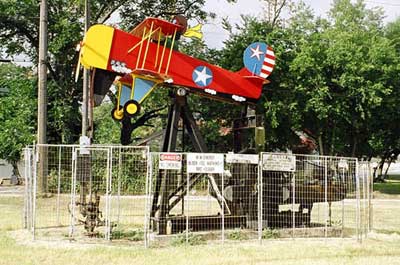
After sampling “the best ribs in the country,” visitors to Luling, Texas, marvel at the many decorated pump jacks seen in its historic downtown.
Some people proclaimed that Davis, president of the exploration company, found the town’s oil-rich geologic formation after getting a psychic reading from clairvoyant Edgar Cayce. A geologist working for Davis figured out the oilfield’s likely location.
“Many have called Edgar B. Davis eccentric, and perhaps it was his unconventional personality that led to several half-truths about a career that would be exceptional without embellishment,” noted Riley Froh in a 1979 article in the East Texas Historical Journal.
In the early summer of 1922, Davis was struggling financially when he located the oilfield’s discovery well five miles northwest of Luling. “Drilling on the recommendation of only one geologist and against the advice of several, Davis located his seventh well at random,” Froh reported.
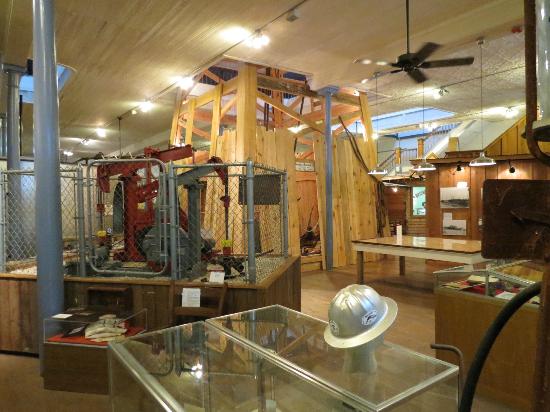
Luling’s downtown museum preserves “the vibrant life and times of the ‘the toughest town in Texas’ and the oil boom in the Central Texas oil patch.” Photo courtesy Luling Oil Museum.
By 1924, Luling was a top-producing oilfield in the United States, exceeding the early 1900s fields of southeastern Texas, including Sour Lake and even the world-famous Spindletop Hill.
Exhibits at the Luling Oil Museum focus on the real science behind the discovery, which resulted in the town’s population skyrocketing from less than 500 people to 5,000 people within months after the Rafael Rios No. 1 well.
Psychic Dreams of Oil
Biographers of the once famous American psychic Edgar Cayce have noted that he found his own mysterious path into exploring the oil patch at Luling. In 1904, Cayce was a 27-year-old photographer when a local newspaper described his “wonderful power that is greatly puzzling physicians and scientific men.”
The Hopkinsville Kentuckian reported that Cayce – from a hypnotic state – could seemingly determine causes of ailments in patients he never met. By 1910, the New York Times proclaimed that “the medical fraternity of the whole country is taking a lively interest in the strange power possessed by Edgar Cayce to diagnose difficult diseases while in a semi-conscious state.”

As his reputation grew, Cayce expanded his photography business with the addition of adjacent rooms and a specially made couch so he could recline to render readings. He became known as “The Sleeping Prophet” while his readings expanded beyond medical diagnoses into reincarnation, dream interpretation, psychic phenomenon…and advising oilmen.
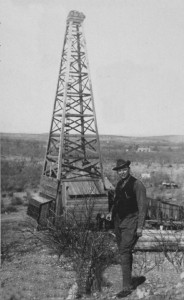
Edgar Cayce visited his drilling site in San Saba County, Texas, in 1921. The once-famous psychic’s abilities failed him searching for oil.
Sidney Kirkpatrick, author of Edgar Cayce: An American Prophet , explained that Cayce in 1919 provided detailed trance revelations to several oilmen probing the prolific Desdemona oilfield in Eastland County, Texas. The results reportedly inspired Cayce and several partners to form their own company.
, explained that Cayce in 1919 provided detailed trance revelations to several oilmen probing the prolific Desdemona oilfield in Eastland County, Texas. The results reportedly inspired Cayce and several partners to form their own company.
In September 1920, Cayce became the clairvoyant partner of Cayce Petroleum Company. Guided by his own psychic readings, Cayce Petroleum Company leased some acreage around Luling. Not far away, Edgar B. Davis had drilled eight dry holes and nearly went broke before completing the discovery well for Luling’s oilfield.
But raising capital for Cayce Petroleum drilling proved difficult and eventually led to loss of the Luling leases. Cayce’s company tried again 150 miles north in San Saba County, Texas, and according to Kirkpatrick’s book, Cayce’s readings included “detailed descriptions given of the various rock geological formations that would be encountered as they drilled.”
Cayce Petroleum’s Rocky Pasture No. 1 well would drill beyond 1,650 feet in search of what Cayce described as a “Mother Pool,” capable of producing 40,000 barrels of oil a day. The psychic’s exploration company did not find any oil, ran out of money, and failed.
Salt Dome Faults
In a 2017 email to the American Oil & Gas Historical Society, long-time AOGHS member Dan Plazak noted Cayce spoke of finding oil at a salt dome at Luling. Petroleum and the geology of salt domes had been in the news since one had been revealed at Spindletop Hill in 1901, thanks to the persistence of Patillo Higgins, “Prophet of Spindletop.”

Plazak, a consulting geologist and engineer, reported that Cayce, “speaking in a trance, proclaimed that oil would be found at Luling associated with a salt dome. But there are no salt domes at Luling, and Cayce’s bad psychic advice could only have prevented Davis from finding oil.
“It was a geologist working for Davis who saw faulting in the outcrop, and correctly predicted that the oil would be trapped behind the fault,” Plazak added.
An associate of Cayce, David Kahn, later wrote Davis asking the successful oilman to give some of the Luling profits to Cayce, but Davis declined. “Edgar Davis was famously generous, but his refusal to reward Cayce indicates that he didn’t consider Cayce to have been of much help,” explained Plazak in an email to AOGHS.
However, the geologist added, Davis continued to consult Cayce concerning possible presidential ambitions — Davis had convinced himself he was destined for the White House.
Plazak explained that it was a geologist working for Davis who saw faulting in the outcrop, and correctly predicted that the oil would be trapped behind the fault.
After a few early wells, “Cayce’s oil-exploration readings were a complete bust, both for his own oil company and later for many other oil drillers, in locations all over the country.”
In his email, Plazak — a “geologist and researcher of finding oil with doodlebugs, dreams, and crystal balls” from Colorado — added there are still those today who believe in psychic advice who no doubt are “raising money on the internet to drill yet another dry hole in San Saba County.”
Despite the psychic’s exploration readings not working, investors apparently can still be tempted with promotions of Cayce’s ability to find a “mother pool of oil.” More interesting research from oil patch detective Dan Plazak can be found at Mining Swindles.

A graduate of Michigan Tech and the Colorado School of Mining, Plazak in 2010 wrote “an entertaining and informative volume that delightfully investigates the history of mining frauds in the United States from the Civil War to World War I,” according to his publisher, the University of Utah Press.
“In his estimable work, A Hole in the Ground with a Liar at the Top, Dan Plazak strikes it rich with his examination of the old west’s most successful villains and their crimes.” — Utah Historical Quarterly
Modern “Crudoleum”
Today, the psychic legacy of failed oilman Edgar Cayce lives on at the Association for Research and Enlightenment in Virginia Beach, Virginia, founded in 1931, and “the official world headquarters of the works of Edgar Cayce, considered America’s most documented psychic.”

A psychic’s petroleum product sold today.
An invention from Cayce’s venture into the oil business remains on the market — his “pure crude oil” product he recommended as a first step toward replenishing healthy hair. Cayce invented a “pure crude oil” product he called Crudoleum, which is sold today as a cream, shampoo and conditioner. Baar Products Inc. of Downingtown, Pennsylvania, offers Crudoleum Pennsylvania Crude Oil Scalp Treatment.
_______________________
Recommended Reading: Texas Art and a Wildcatter’s Dream: Edgar B. Davis and the San Antonio Art League (1998); Drilling Technology in Nontechnical Language
(1998); Drilling Technology in Nontechnical Language (2012); Edgar Cayce: An American Prophet
(2012); Edgar Cayce: An American Prophet (2001); A Hole in the Ground with a Liar at the Top: Fraud and Deceit in the Golden Age of American Mining (2010). Your Amazon purchase benefits the American Oil & Gas Historical Society. As an Amazon Associate, AOGHS earns a commission from qualifying purchases.
(2001); A Hole in the Ground with a Liar at the Top: Fraud and Deceit in the Golden Age of American Mining (2010). Your Amazon purchase benefits the American Oil & Gas Historical Society. As an Amazon Associate, AOGHS earns a commission from qualifying purchases.
Learn more U.S. petroleum history by visiting the Luling Oil Museum in the historic Walker Brothers building in downtown Luling.
_______________________
The American Oil & Gas Historical Society (AOGHS) preserves U.S. petroleum history. Please become an AOGHS annual supporter and help maintain this energy education website and expand historical research. For more information, contact bawells@aoghs.org. © 2024 Bruce A. Wells.
Citation Information – Article Title: “Central Texas Oil Patch Museum.” Authors: B.A. Wells and K.L. Wells. Website Name: American Oil & Gas Historical Society. URL: https://aoghs.org/energy-education-resources/luling-oil-field. Last Updated: August 1, 2024. Original Published Date: June 21, 2015.
by Bruce Wells | Jul 19, 2024 | Energy Education Resources
Geologist tracks down first references to petroleum sightings.
Geologist and historian Raymond P. Sorenson has spent much of his professional career writing about the oil and natural gas exploration and production industry.
Among Sorenson’s ongoing projects is documentation of the earliest signs of oil worldwide, including references to hydrocarbons long before the 1859 first U.S. oil well drilled 69.5 feet into the Venango sands of Pennsylvania.
About three centuries earlier, a Spanish expedition in the Gulf of Mexico led by Don Luis de Moscoso landed at the mouth of the Sabine River in the future state of Texas. The New World explorers in 1543 discovered Indians had for centuries utilized natural seeps to waterproof canoes, apply to abrasions, and more.
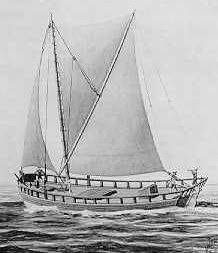
A Spanish expedition in 1543 used brigantines to explore the coast of the Gulf of Mexico.
Sorenson, retired and living in Tulsa, initially focused his research on geological surveys, reports from other exploring expeditions, and scientific journals. He then progressed to references cited by others, concentrated his efforts on North America and English language sources — the most readily available — but discovered rare sources as well.
Oil in Antiquity to Today
The petroleum geologist’s ongoing work has added more than 740 reference pages (with captured images) of his sources for the earliest signs of hydrocarbons in North America and other parts of the world.
Sorenson in 2020 shared with the American Oil & Gas Historical Society his bibliography of “Pre-Drake” publications. “For the past few years I have been engaged in a systematic study to document what was known about oil and natural gas prior to the Drake well,” he noted.

“I have an additional list of cited references that I have not yet examined of comparable size,” Sorenson added in a follow-up email to AOGHS. “The majority are in languages other than English, and I suspect that many of them will not be accessible through my library resources (or my linguistic skill set).”
A petroleum historian and consulting geologist based in Tulsa, Oklahoma, Sorenson explained in his email to AOGHS that to aid researchers, he has been using images of every page that contains relevant material, posting the full reference information at the top, and outlining the relevant portion of the text.
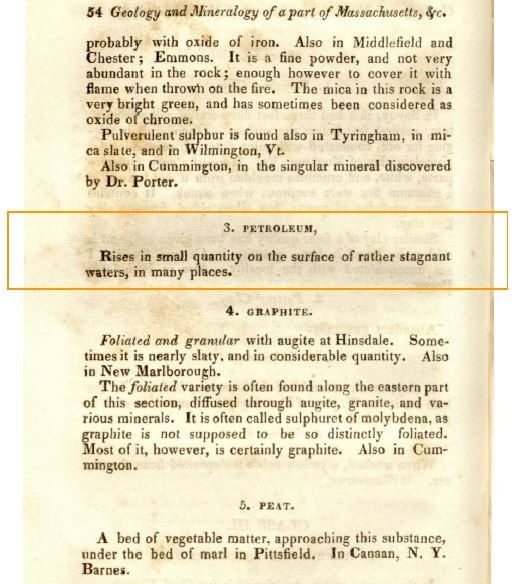
An 1835 reference to signs of oil and natural gas in Massachusetts prior to the first commercial U.S. oil well in Pennsylvania. Image courtesy Ray Sorenson.
“So far I have found relevant information in more than 550 publications with over 3,500 net pages, covering at last count 31 states, five Canadian provinces, and many foreign countries on other continents,” Sorenson noted in January. “For several topics, I have created subsets. I expect to continue to build the collection.”
In addition to antiquity references, Sorenson’s research for his “Pre-Drake Literature Collections by Subject” has thus far included:
California, Canada, Central & South America, Early Geologists, Europe, Fiction, Humboldt, Industrial & Laboratory, Initial Reactions, Kentucky, Maps & Figures, Medicinal , Middle East Asia Africa, Midwest, New England, New York, Oil & Gas Wells Pre-Drake, Ohio, West Virginia, Pennsylvania, Religious, Scientific American, Shales that Burn, Southern United States, Taylor R.C., Statistics of Coal, Textbooks, Volcanoes and Earthquakes, David Wells, Annual of Scientific Discovery, and Western United States.

Although many of his discoveries were found in obscure scholarly journals, Sorenson also found petroleum references in popular 19th-century publications. For example, the April 18, 1829, issue of “Niles’ Register” reported a Kentucky salt well driller finding oil.
“We have just conversed with a gentleman from Cumberland county, who informs us that in boring through rocks for salt water, a fountain of petroleum, or volatile oil, was struck, at the depth of 180 feet,” the Baltimore publication noted on page 117.
Sorenson’s Research Gigabytes
A long-time member of the American Association of Petroleum Geologists (AAPG) and the Petroleum History Institute (PHI), Sorenson has made many presentations and published academic papers with both. He submitted to PHI a paper on his history of oil and natural gas production from wells prior to 1859 for the journal Oil-Industry History.
The wells were drilled seeking water or brine, but Sorenson found one that flowed an estimated 2,500 barrel of oil per day in the 1820s.
In 2007, Sorenson adapted many of his contributions to AAPG for its extensive Discovery Series with “First Impressions: Petroleum Geology at the Dawn of the North American Oil Industry.” In January 2013, his “Historic New York Survey Set High Geologic Standards” was published in AAPG Explorer magazine, one of his many contributions to that publication.

Sorenson, who also has assisted with AOGHS articles (see Rocky Beginnings of Petroleum Geology), noted in his email he does not yet plan to provide this collection in searchable form on a website, but will work with anyone who is conducting similar historical research.
Everything in the Sorenson collection is preserved in hard copy and digital (PDF) form, adding up to 11 feet of shelf space — about 27 gigabytes of computer memory.
Sorenson intends to give his full collection of research to the Drake Well Museum and Park in Titusville, at the site where Edwin L. Drake first found oil in the upper Venango sands.
Today, the Oil Region Alliance of Business, Industry and Tourism proclaims that historic part of northwestern Pennsylvania, “The Valley that Changed the World.”
For more information about Ray Sorenson’s on-going oil history projects and resources, post a comment below.
_______________________________
1859 Pennsylvania Well
The beginning of the science of petroleum geology might be traced to 1859 when a new industry began in western Pennsylvania. An oil well drilled in 1859 by former railroad conductor Edwin L. Drake along Oil Creek at Titusville sought oil for making kerosene, a new lamp fuel at the time made from coal.
Slowed by delays in receiving funds for what locals called “Drake’s Folly” and drilling with a steam-powered cable-tool rig, it took Drake more than a year to find oil at a depth of 69.5 feet. He also made his own innovations along the way, including adding a 10-foot cast iron pipe to the bore hole — a first.
To the relief of company founder George Bissell and investors in the Seneca Oil Company of New Haven Connecticut, Drake completed the first U.S. oil well drilled specifically for oil. The August 27, 1859, discovery came in a geologic formation that would be called the Venango sands.
_______________________
Recommended Reading: Trek of the Oil Finders: A History of Exploration for Petroleum (1975); The Birth of the Oil Industry (1936); The Prize: The Epic Quest for Oil, Money & Power (2008); Myth, Legend, Reality: Edwin Laurentine Drake and the Early Oil Industry
(2008); Myth, Legend, Reality: Edwin Laurentine Drake and the Early Oil Industry (2009). Your Amazon purchase benefits the American Oil & Gas Historical Society. As an Amazon Associate, AOGHS earns a commission from qualifying purchases.
(2009). Your Amazon purchase benefits the American Oil & Gas Historical Society. As an Amazon Associate, AOGHS earns a commission from qualifying purchases.
_______________________
The American Oil & Gas Historical Society (AOGHS) preserves U.S. petroleum history. Please become an AOGHS annual supporter and help maintain this energy education website and expand historical research. For more information, contact bawells@aoghs.org. © 2024 Bruce A. Wells.
Citation Information – Article Title: “Sorenson Oil History Project.” Authors: B.A. Wells and K.L. Wells. Website Name: American Oil & Gas Historical Society. URL: https://aoghs.org/energy-education-resources/exploring-the-earliest-signs-of-oil. Last Updated: July 18, 2024. Original Published Date: August 5, 2020.


















